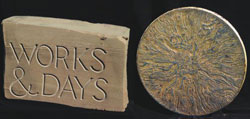Works and days
The Boetian poet Hesiod was a farmer-poet, a combination so familiar to us in Australia. A life which integrates 'the care of trees, of the cattle and fields' with drawing, pointing and writing, has a deep appeal. Hesiod gives us in 'Works and days', homilies, wisdom literature, practical advices, auspicious times to act, to sow, to reap; something like the old Women's Weekly.

This exhibition of drawings, paintings and inscriptions is principally about a residency in Hill End in early 2004, and continuing visits over the following months. The extreme heat of summer ended with violent thunderstorms and a cool change almost on the day I arrived.
Suddenly the chooks were no longer dying in the chookyards and everyone could resume normal life. The baked hills over the plateau from Monkey Hill to Hill End gradually tinted green. The Turon river deep in the valley (named for a river in Portugal) was not to flow till August or September.
The cottage, originally Warry's and Lister's, was bought in the late 1940s by Donald Friend, was the studio a shelter for several painters as they interpreted the village, and was given to Donald Murray by Tas Drysdale in the 1960s, before finally becoming an artist's residency under the care of Bathurst Regional Art Gallery in the 1990s.
Accepting the challenges of the residency, you are trying to fill many large and small shoes of your predecessors. Friend's published diaries record daily life in the cottage with such immediacy: Hill End goings on, storms, livestock breaking into the garden, building the courtyard, the discovery of a hidden gold nugget in a jug in the house: many events find echoies in your own daily adventures. Olley and Drysdale and many others cast their eyes over the decayed town and found an answer.
The Hill End experience seems to work as a self-fulfilling prophecy. You come as an a artist, expecting a breakthrough, observation pitched to a high level, honoured to have been given the residency, knowing your time can be unusually dedicated to your work: and with surprising consistency, results follow. As if by a secular consecration, Hill End has been able to transcend mere 'heritage' to become a great conversation.
Donald Friend sent his early drawings of ruined gardens and the mined-out landscape to REA Wilson, his old astute London dealer. Wilson replied: 'Do you know the Shoreham watercolours of Samuel Palmer? A garden wall, a bare apple tree in winter, all with such nostalgic perfection.'
Perhaps the substance that Wilson recognised in Friend's subject and interpretation was associated with elegiac tones common to Palmer's Shoreham work, and to the old mining landscape. A landscape poetically shaped by the thythms and struggles of other lives against the eternal lights of sun, moon and stars, has romantic and nostalgic appeal without sentimentality. The old fruit trees and ruined cottages - planted and built by people who, like the artists of the 1940s, were so extraordinarily young at this time - make 'time passing' a visual, tangible quality. While we are all aware that the pathetic fallacy can affect such subjects, they are also intensely interesting figures in the landscape. Neglect and economic failure have been the greatest blessings for Hill End (for the artists at led ...ast) in the same way that drought and erosion in the 1940s provided the gift of some of the most memorable and poetic images of the inland when Drysdale and others travelled there. It's an ill win
The inscriptions in the exhibition are extracted from many sources, but a common thread is the atmosphere of old gardens, the bright skies, and Romanticism. The Van Morrison song 'Sweet Thing'
And we shall walk and talk in gardens
All misty and wet with rain
And we shall never, never grown so old again
and also
And I will raise my hand up
Into the night-time skies
and count the stars
that are shining in your eyes.